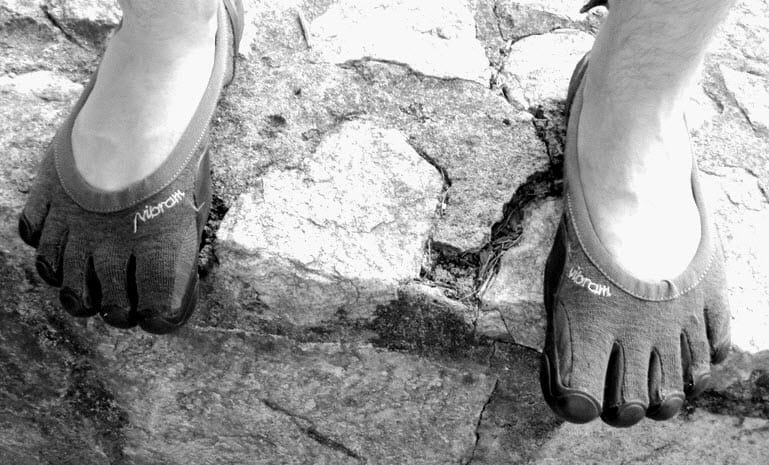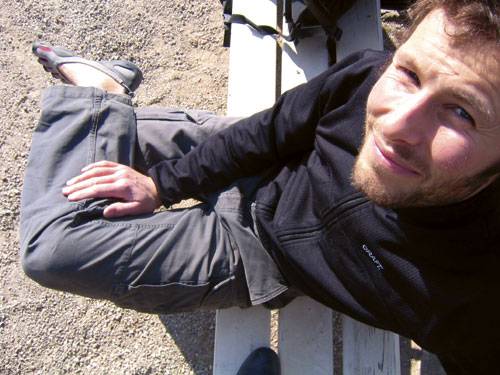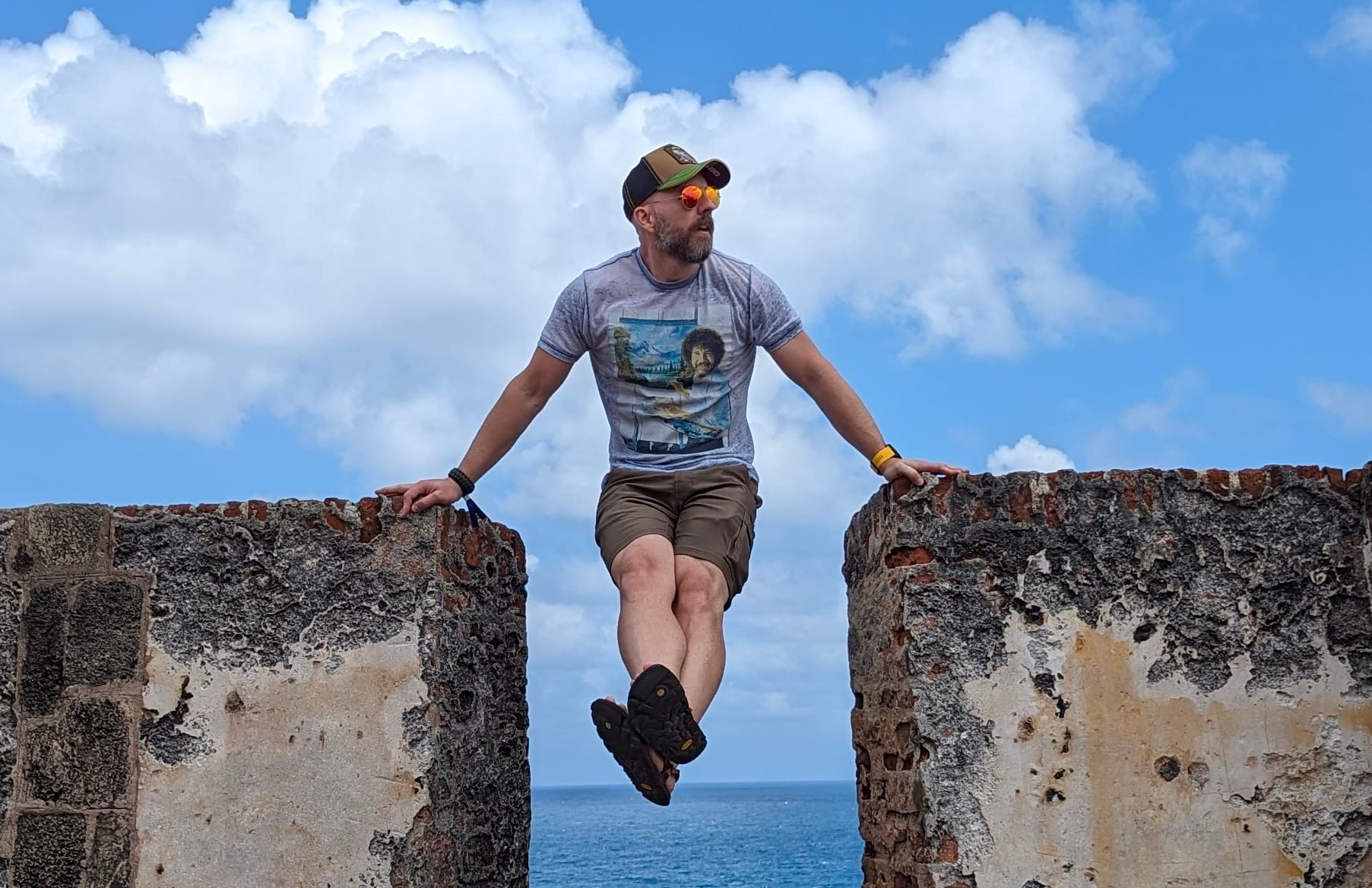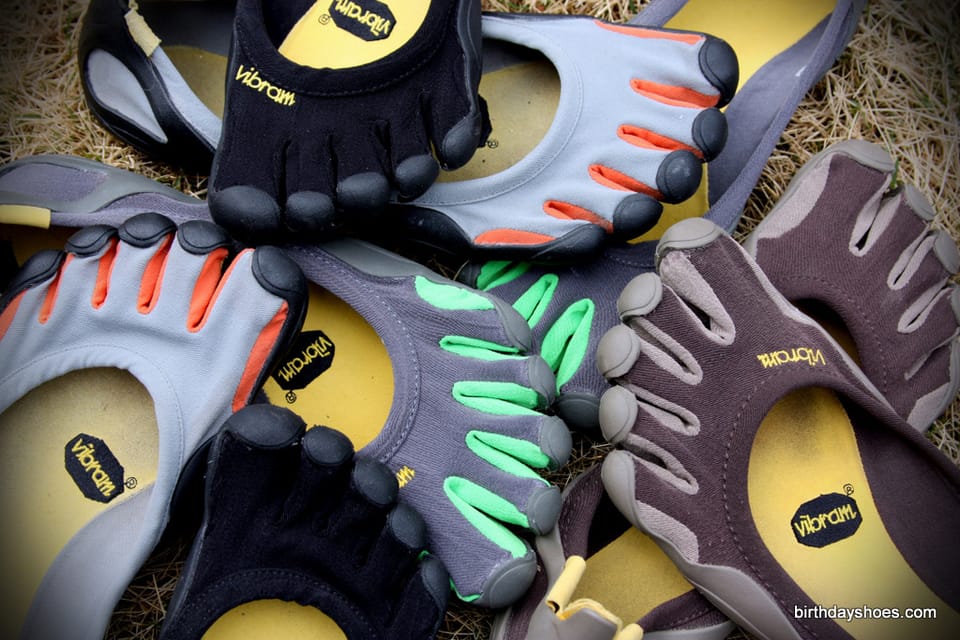New Balance MT100 and MT101 Zeroed Out and Reviewed
What follows are two posts from Tuck's blog Yelling Stop in which Tuck, a minimalist runner in search of great foot friendly shoes (See "barefoot running shoes" defined), discusses having a pair of New balance MT100s modified by a…
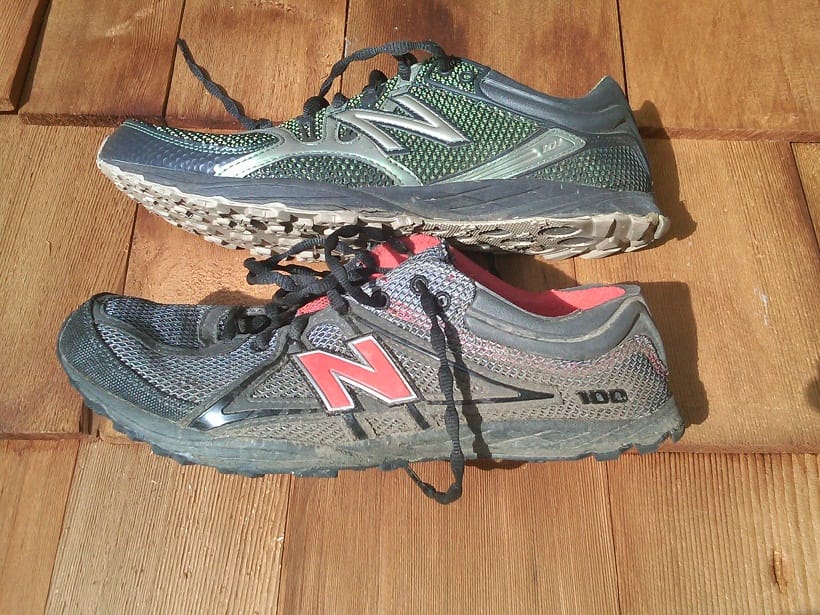
What follows is best described as a minimalist running enthusiast's quest for foot-friendly "barefoot running shoes" — alternatives to Vibram Five Fingers. Anyone whose had VFFs long enough will tell you that, unfortunately, they don't always cut the mustard — such as in particularly cold weather or when you have a broken toe. Tuck, who you might remember from his custom Russell Moccasins based off the Munson Last, is now blogging regularly over at Yelling Stop. Recently, Tuck shared his attempts to improve upon the New Balance MT100 by zeroing them out back in November 2009. He talks about how they worked post-mod, how he used them, and how he ultimately switched to his custom Russell Mocs in December 2009. Fast forward to now and Tuck has taken another stab at zeroing out New Balance shoes — this time, the new New Balance MT101s.
More after the jump
Modified New Balance MT100s — November 2009
I got back from the cobbler with a pair of modified New Balance MT100s in hand, and if you didn't know what they were supposed to look like, I don't think you could tell what had been done with them. Fortunately, I had another pair of unmodified MT100s around, so I'll do some side-by-side comparisons.
I did try them on at the cobbler. Standing in a resting position, my heel just kisses the ground with the weight resting on the ball of the foot. Just like my Vivo Barefoot shoes or being actually barefoot. So I consider them to be a success in that regard.
Unfortunately, at the time I had a broken pinkie toe, and was unable to run more than a short distance without pain. I ran in them later, and the rock-guard plate helped support my forefoot and toe enough to allow me to run.
A little later...
OK, here they are — a 9.5 men’s MT100 compared to a 10.5 men’s MT100. Neither pair had been worn outside for running when these pictures were taken. My friend (a convert to Vibrams ) also bought the MT100s for winter running when we went to the store. He also has no desire to run in them if it's warm enough for KSOs. He had a big shin splint issue until he learned to run barefoot-style.
Here's the before and after
I propped up the heel of the altered shoe so that you get a good idea of what was removed.
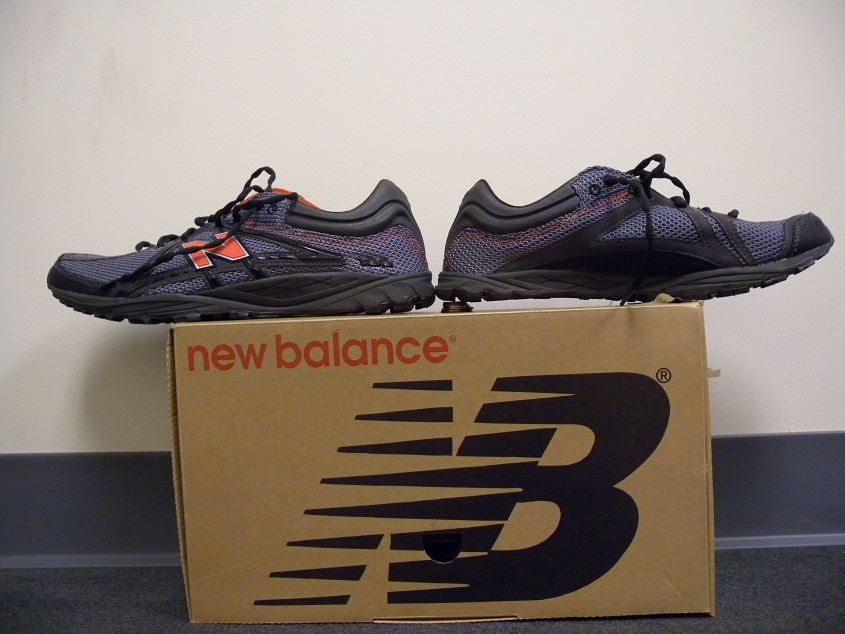
MT 100 Compare
Here's the close up
The workmanship on the altered shoe is better than the original, I just noticed.
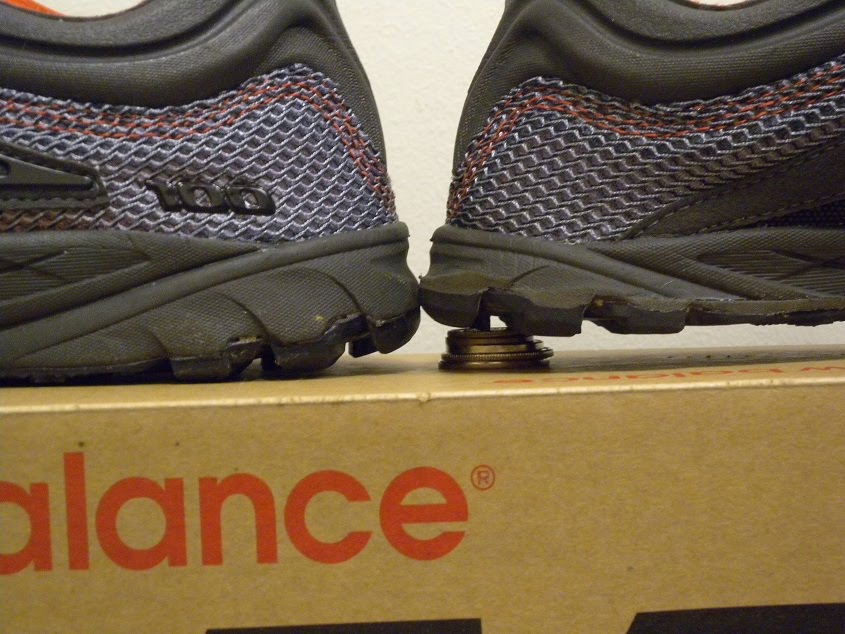
Compare (Near)
The soles
You can see in this shot where he cut a little low, and cut through the top of the dimples. This is entirely cosmetic, I don't know if the dimples even reduce weight much, as they're pretty shallow. The altered shoe is the smaller one. Those orange circles are the stone guard that you can see through the sole.
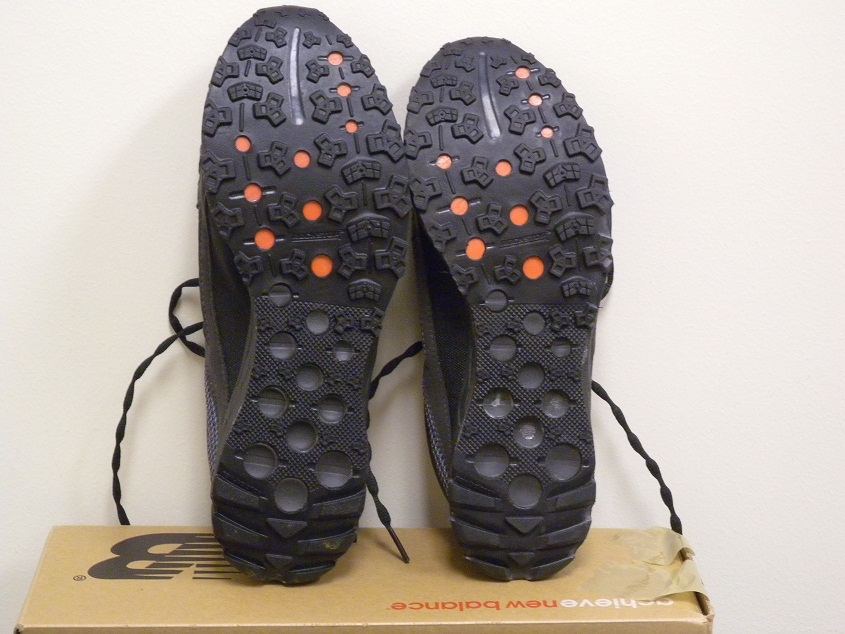
Compare Soles
Workmanship
Just so you can see what the workmanship looks like up close.
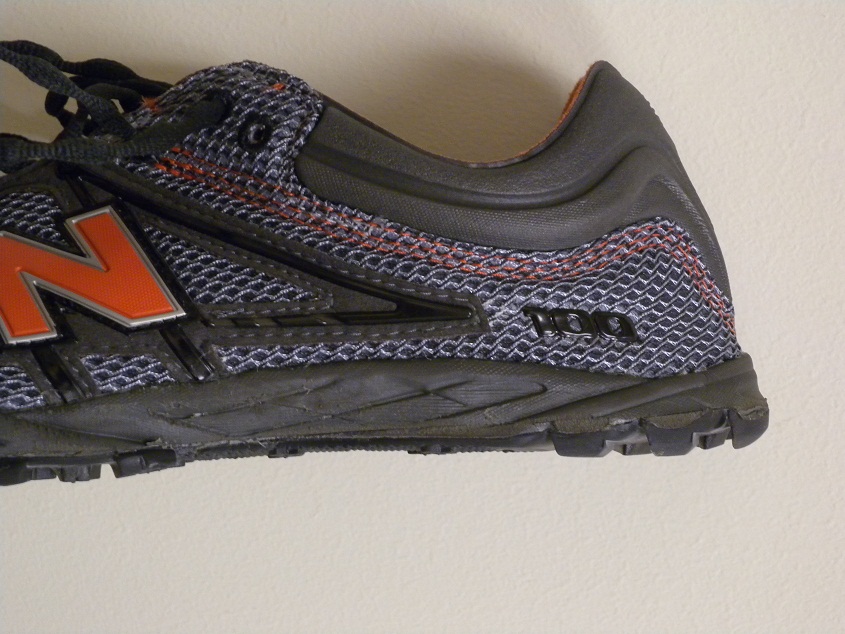
Closeup of the Heel
The Results — Minimalized New Balance MT100s
The cobbler wasn't able to peel the sole away, so wound up having to cut it down. I don't know that that makes any difference in practice, but if you have any ideas of your own, there you go.
David (the Cobbler & Cordwainer) mentioned to me that there was still a pretty built-up arch in the sneaker, and that we could cut away the insole to reduce that. I didn't listen in his shop, and spent the rest of the afternoon wondering what the heck that lump under my arches was, as I was wearing them without the insole. I put the insole back in, and it lessens the arch, but I think I'm going to follow his advice (and listen a little more closely next time he has a suggestion).
The toe spring is not really an issue as the toe area is really soft. I can flex it down almost flat without a problem. Excessive toe spring is a problem if you cut the heels off, the toes can wind up pointing to the heavens, which is not comfortable.
Sneakers are really warm! Too warm. I've gotten used to having cool soles in the Vibrams and the Vivos. I hadn't realized it until I put these on. But since I want these for winter running, I guess that's a feature.
With the insoles in and the plate under the ball of the foot my busted foot feels much better. I rann in them in the morning after getting them back from the cobbler, to see how they did. And how I would do. The shoes performed well, and the rock plate did a fine job of supporting my busted pinkie toe.
These are a very different shoe from the Mizuno flats, which was a popular minimalist running option when the MT100 first was released, as they're a trail running racing flat. So they're heavier, and have a beefier sole with a more aggressive tread, and the stone guard. But with the kind of running I do in these, I think that's appropriate.
Ideally Inov-8 will make something that will make it unnecessary for me to go through this exercise again. The sneakers are $75, labor $50 = $125, or the same cost as the Vibram Treks.
Some thoughts on Zeroed out New Balance MT100s
I was able to find another cobbler who did another pair (the unmodified pair in the pictures above) for $25.
I ran in these pretty regularly last winter, but found after a while that they gave me runner's knee. Reverting to Vibrams cured the runner's knee immediately, while going back to the 100s brought it back. Even wearing the Russell moccasins, which I had made in December 2009, was better for my knee — despite the weight. My colleague, owner of the unmodified pair above, had the same thing happen to him, and I'll note that Anton Krupicka, the athlete for which these were designed, has been battling a similar issue for quite some time.
I ran one race in the New Balance MT100s despite the runner's knee and they did OK; it was a 20k and I managed an 8:11 pace. The knee hurt quite a lot, so I pretty much stopped running in them after getting my Russells.
I still use them occasionally as back up shoes or casual shoes, and I broke them out again for a recent trail half-marathon. I broke or dislocated the other pinkie toe two times in KSO Treks, and I don't feel like doing it during a race, so I wore the MT100s. Sore knees aside, with some warm wool socks they worked great in the snow, and during the half-marathon.
Take Two: Zeroed out New Balance MT101s
... and a comparison to the zeroed out New Balance MT100s
When New Balance released the MT100 last year, minimalist runners were quite excited. The good news about this shoe was that it was designed for famed (in the ultra-running community) minimalist runner Anton Krupicka. Minimalist features included: a flexible sole (except for the rock plate), a breathable design geared to be worn without socks, and light weight.

Side view, 101 on top
But nothing is ever perfect in the first draft. There were a few relatively minor issues with this shoe: it was a bit narrow across the front of the toe, and the tongue and the ankle collar tended to bother some people (If you look closely at the Side View picture, you'll note that the part of the 100 that rides up the achilles is missing, while it's present on the 101. It's missing because I cut it off with a razor knife after attempting to run sockless in the 100s one summer day. This only took a moment, and significantly improved the shoe.)
The soles on both the New Balance MT100 and MT101 are functionally identical. The toe area on the 101 may be a smidge wider, but this seemed to have no effect other than to avoid feeling like the soles were a tad narrow, which did occur sometimes in the MT100, especially when running down hill.
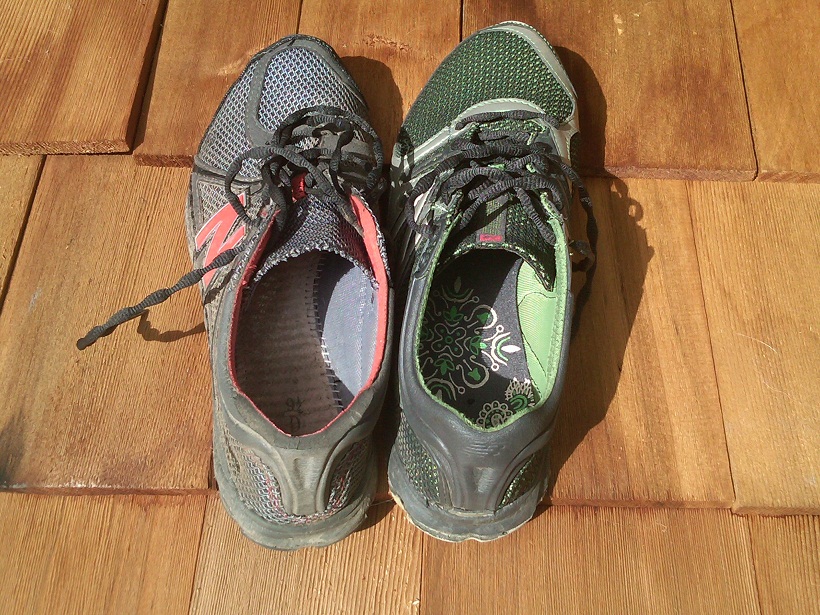
Rear view, 101 on right
Unfortunately, one feature carried over from the MT100 to the MT101 is the 10mm differential with the heel. In the side view photo you'll notice that both shoes have had the heel zeroed (reduced to a similar height, approximately 8mm). The 10mm heel differential is gone. The 101 and 100 were done by two different cobblers, and since this is a manual process, they're slightly different, but after a few minutes of running feel the same.
The New Balance MT101 is indeed wider across the toes, although upon trying them on they felt like they were crowding my big toe a bit. This may be a function of the fact that I've been wearing my MT100s without the insole. To give my toes enough room I bought the MT101s in a size 10 versus the 9.5 in the MT100, so I have a comfortable fit even with the insole. This allows for a bit more protection in the heel area when racing. There is enough room in the toe to splay my toes when running downhill, and that, along with wearing the insole, allowed me to bomb down hills heedless of the rocks.
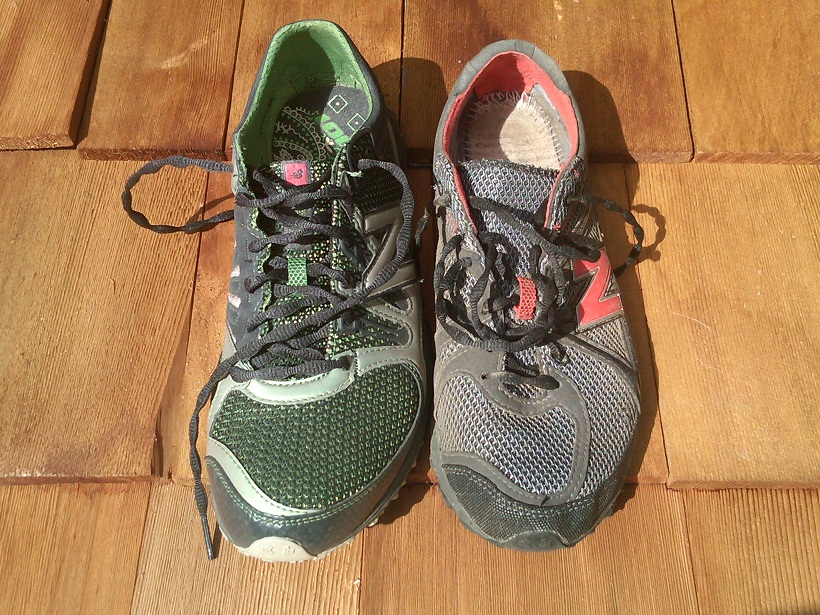
Front view, 101 on left
New Balance also slightly changed the tongue on the MT101. I never had any problems with the prior tongue, but if you did, rejoice.
They also significantly redid the overlays on the top, and the material seems to breathe much better than the MT100 did. The laces are either the same, or are so similar that I can't tell the difference.
The one welcome improvement is that the Achilles-tendon slicer at the top of the heel on the MT100 is much reduced on the MT101, and the soft liner material (light green in the picture) curves over the plastic material which was formerly so effective at gashing your leg. I've not tried running sockless in the MT101 yet, but hope to have a pleasant time of it.
I had only worn the MT101 around for about half an hour prior to sending it to the cobbler for a heel-ectomy. I picked them up Saturday afternoon for a race on Sunday. Yes, like a fool I took a shoe that I had never even run in once to a trail half-marathon. It occurred to me while in the parking lot at the race start that I was doing this, and that I had sworn I would never do it again after making this mistake with my Bikilas. But I had no other shoes, so I really had no choice at that point.
Happily, they performed perfectly. I wore the exact same pair of socks with the New Balance MT100 and the MT101, and I did not experience any discomfort whatsoever with the MT101. Not a blister, not a hot-spot, no break-in at all. Kudos to New Balance for that. I did stop at about mile 11 and adjust the tongue on one shoe, but that was precautionary.
Modified New Balance MT100 vs. MT101 — Conclusion
So I like both of these a lot. If you can find the MT100 on clearance and make the modifications I did, I think you'll be quite happy with them, while saving some money. Or buy the MT101 and, after removing the heel, wear as is.
My only caveat about these two shoes is that they do have excessive cushioning. Yes, even 8mm is too much for me nowadays. The only knee pain I've ever had in my running career has been from the MT100s last winter (runners' knee), and during the half-marathon training (IT band stiffness). The IT band stiffness repeated the second Sunday in the MT101. I don't know if this is the result of the 101s or of my weakened ankle (detailed in the race report here), so I will withhold judgement. Ideally I'll do the Paine to Pain course again in the next few weeks in my Treks, and see how the knee and ankle do.

